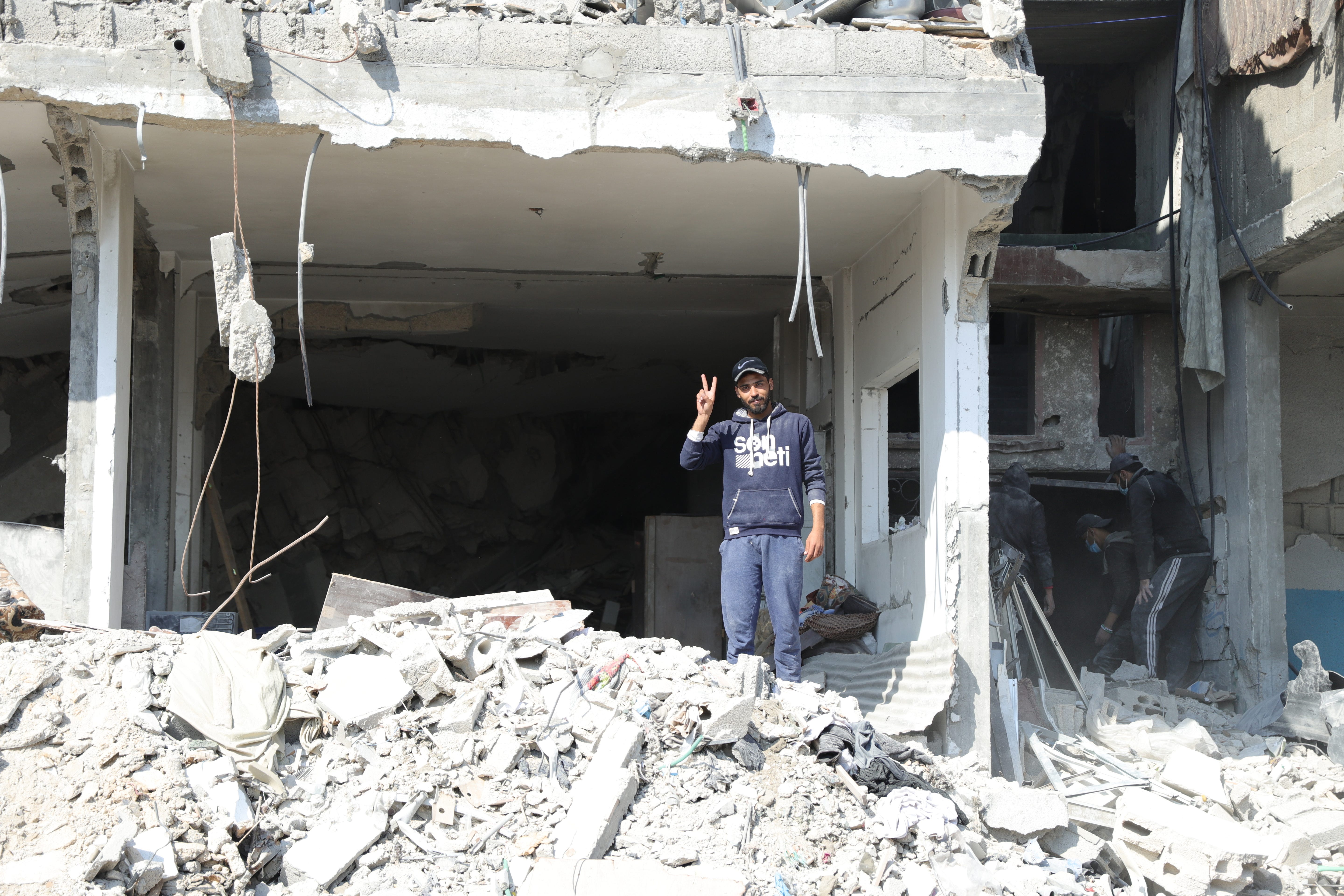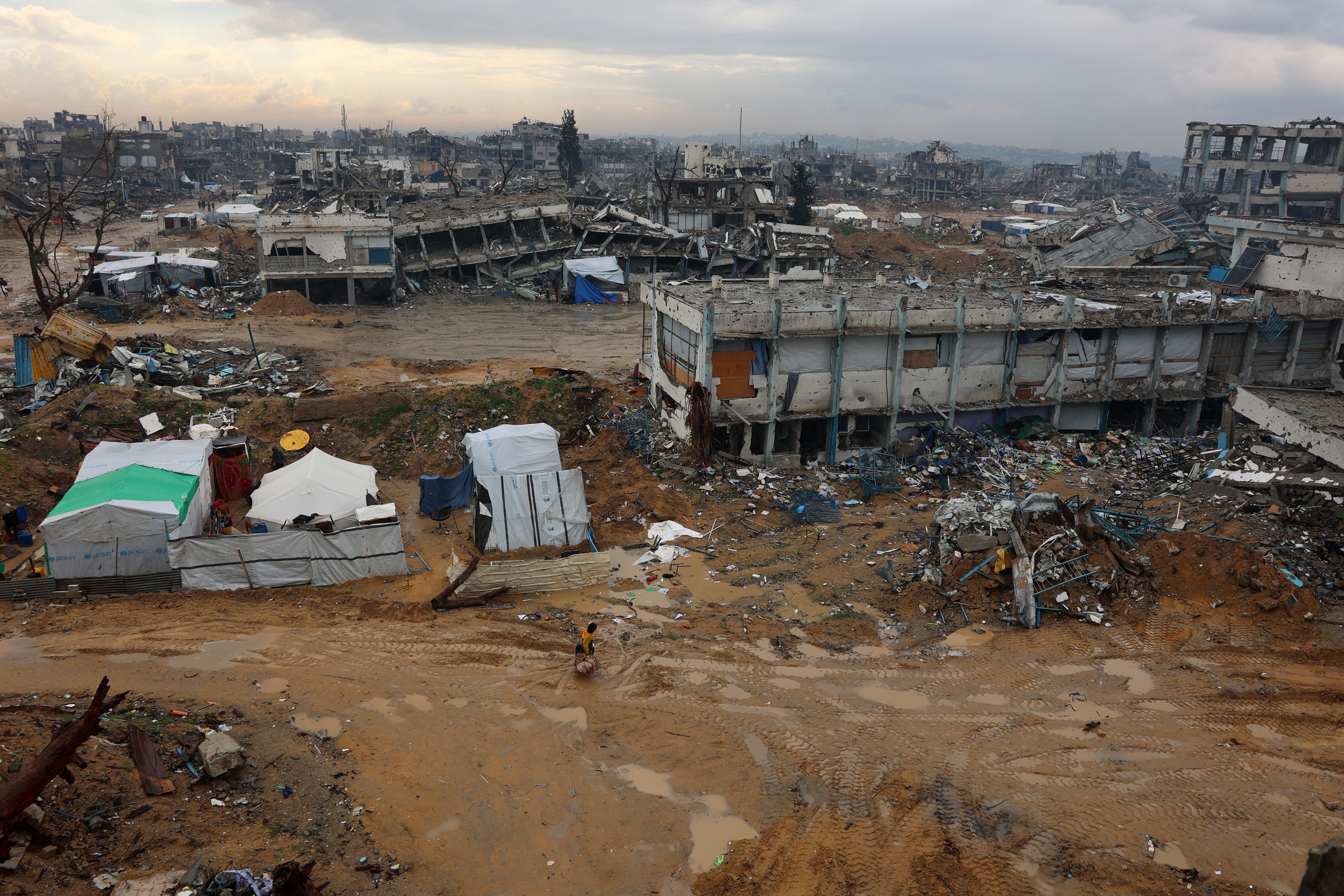Living in the Open: Palestinians in Gaza Still Face Israeli Attacks and Impossible Conditions as They Return Home
It’s been just over a month since the fragile agreement between Israel and Palestinian resistance groups came into effect and Palestinians who faced mass forcible displacement were able to return to their homes, neighborhoods, and land. Many now face daunting prospects of rebuilding, especially in northern Gaza, where the destruction is near total and families set up tents on top of the rubble where their homes used to be.
Hossam Shabat and Rasha Abou Jalal, two reporters working in northern Gaza, both sent us dispatches describing the life-threatening obstacles people now face to restart their lives—and the violence they still face from the Israeli military under the so-called “ceasefire.”

Story by Hossam Shabat and Rasha Abou Jalal
GAZA CITY & BEIT HANOUN—Yousef al-Qarm never imagined he would see northern Gaza again. He was forcibly displaced from his home in Shujaiya, a neighborhood in eastern Gaza City, soon after Israel’s assault began in October 2023. The 42-year-old was finally able to return, making the trip from the south across the Netzarim corridor—the military zone built by Israel to bisect the Gaza Strip. Even though his home, and much of the city, have been reduced to rubble, he says he will never leave here again.
“15 months of humiliation and suffering in displacement were enough,” al-Qarm told Drop Site News as he worked alongside a group of neighbors digging a well near a tent camp where they live. “Here, even if we do not find water or electricity, we will live with dignity.” He vows not to leave Gaza City again “even if it costs me my life.”
Al-Qarm is one of over 500,000 Palestinians that have gone back to the north following a ceasefire agreement between Israel and Hamas that came into effect on January 19. While the bombing has stopped, the suffering has not.
The hundreds of thousands of Palestinians who have returned to the north are not in search of comfort but determined to reclaim their land in a show of defiance and a rejection of their forced displacement by Israel. Yet families now find themselves in a battle for survival—resorting to living in the open, inside dilapidated tents that are little more than wooden frames and ripped cloth offering meager protection from the winter cold. There is no water, no food, no basic necessities for life.
When Ahmed al-Zaanin returned to his home in Beit Hanoun earlier this month after months of displacement, he found no shelter. Like nearly all of the structures here, a town lying on the northeastern edge of the Gaza Strip, his house had been reduced to rubble by the Israeli military.
The 60-year-old spent the first three nights sleeping on the ruins, exposed to the rain and cold without even a tarp to cover him as he waited for tents and other supplies to be brought in. They never came. He resorted to scavenging scraps of wood and torn cloth to build what can only be described as a hovel for animals to provide some protection for him and his family from the elements.
Life in northern Gaza has become almost impossible to maintain. Getting water or finding a piece of nylon for a roof are remote luxuries. Under the terms of the “ceasefire” agreement, 200,000 tents and 60,000 mobile housing units are supposed to be allowed into Gaza, but they largely remain on the other side of the Rafah border crossing, with Israel obstructing their entry.
"The agreement is fragile,” al-Qarm said. “Trump's recent statements about deporting Gaza residents are making the situation more complicated and this increases our concern about renewed fighting."
Occupation forces are even preventing people from returning to the piles of concrete that were once their homes. Umm Mahdi, a resident of eastern Beit Hanoun, tried to return to her destroyed house last week in what is supposed to be a “safe” area only to be met by a hail of bullets. One of her grandchildren was injured in the attack. This was not an isolated incident. Thousands have been prevented from reaching their homes—or what is left of them—and are being forcibly displaced from their land.

The most brutal moments now are when the occupation army positions its vehicles near the homes of citizens and floods the area with gunfire. Israel has repeatedly violated the ceasefire deal since it came into effect on January 19, targeting Palestinians in Gaza on an almost daily basis with over 130 killed over the past month, according to the Ministry of Health.
(Last week, as Hossam Shabat, one of the co-authors of this piece, was documenting events for Al Jazeera, he found himself trapped with colleague Mohammed Mohana under a barrage of bullets in the eastern area of Beit Hanoun. The siege lasted for hours.)
The Director General of the Government Media Office in Gaza, Ismail al-Thawabtah, accused Israel of deliberately “delaying the implementation of the humanitarian protocol within the ceasefire agreement.” This week, al-Thawabtah told Al Jazeera that "no more than 11,700 aid trucks have entered the Gaza Strip since the ceasefire began, well below the 18,000 trucks that should have entered since late January.
Al-Thawabtah called on the international community to "assume its moral and legal responsibilities, and intervene immediately and seriously to stop this humanitarian crime, and hold the occupation accountable for its continued violations of international laws and norms."
In Beit Hanoun, Fares al-Ghoul was busy securing wooden planks and plastic sheets inside his damaged home, trying to create some shelter for his family of seven from the winter cold. The sound of Israeli tanks positioned near the city 700 meters from the border rumbled in the distance.
"When the war broke out on October 7, 2023, I was displaced with my family to the southern Gaza Strip. I moved more than 9 times between the cities of the south, fleeing the bombing and searching for shelter," al-Ghoul, 38, told Drop Site while taking a short break from working on the house.
He refused to take the comments about forcibly relocating the entire population seriously. "Trump is a man of deals, he knows very well how to extract positions,” he said. “I believe that he made these statements to intimidate the Arab countries and force them to pay money to rebuild the Gaza Strip.”
While he expressed real fears that the ceasefire would fall apart and the Israeli assault would resume, he refused to leave the north again.
"Our displacement to the south was a grave mistake that will not be repeated,” he said. “If war happens again, I will be displaced from my town to another town inside Gaza City, and I will not be displaced to the southern Gaza Strip again."








Thank you for your on-the-ground reporting. Long live Palestinian resistance!
To see the devastation of the Gaza Holocaust is sickening.
Am I being antisemitic if I wish the same devastation upon Israel.
If I wish Telaviv to be turned into rubbish pile, In the same way that Israel has turned Gaza into a pile of rotting bodies under tons of rubble.
Is that antisemitic. If I say the pox against the perpetrators of this Holocaust
Surely thats not hurting the terrorist state of Israel too much.
lauriemillerjade.com